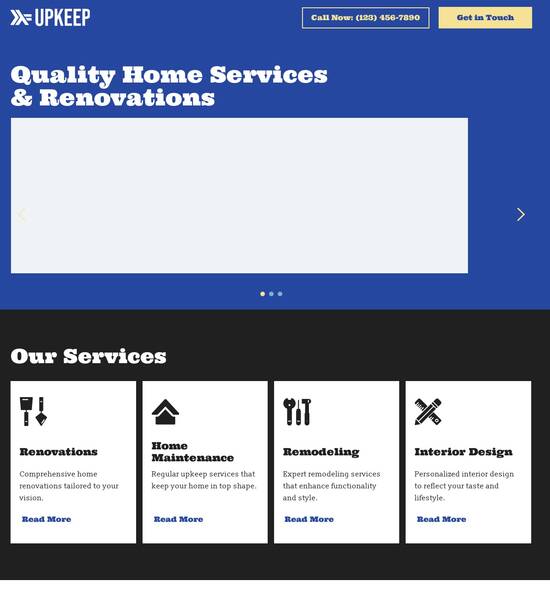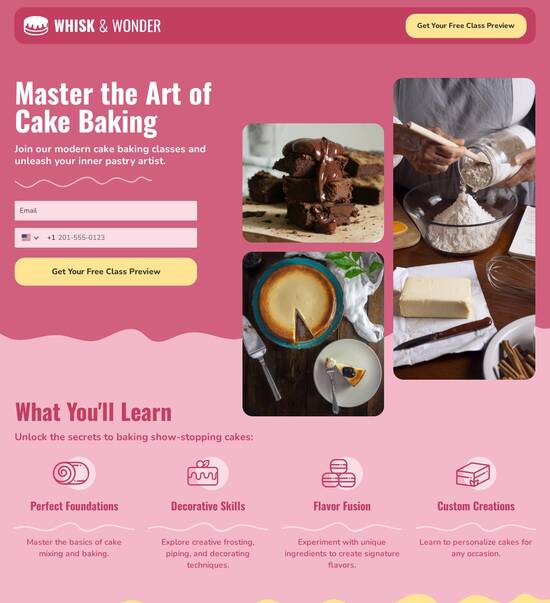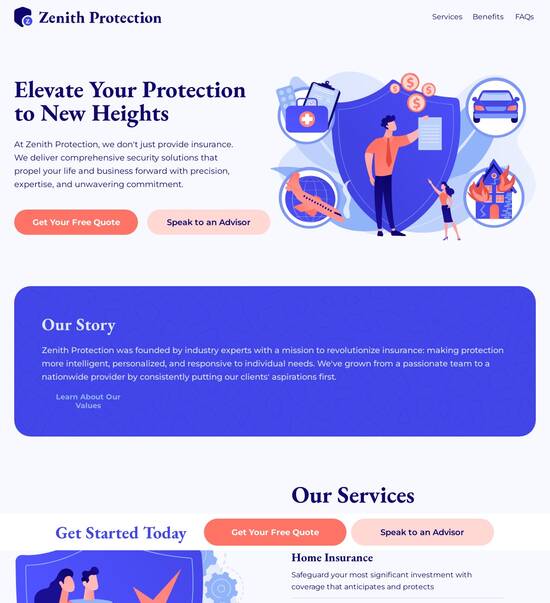
PWA directory listing page template
Explore Similar TemplatesAbout template
Unleash your creativity with the PWA directory listing page template. Try Instapage today.
Recommended templates

Easy to build without coding
With the intuitive drag-and-drop builder, anyone on your team can create high-converting pages without any knowledge of code or design. Make enhancements to your landing page with custom widgets using Javascript, HTML/CSS, or third-party scripts.

Multiple layouts for any industry and goal
Select from 500+ landing page layouts built to boost conversions across industry-specific scenarios. Customize them by adjusting fonts, adding images, and generating on-brand content with the AI assistant. Quickly scale with Instablocks® and Global Blocks that you can save, reuse, and update globally.

Loads fast and looks polished on any device
Every template is responsive, which means they present professionally on any device and load blazingly fast with our Thor Render Engine. You can also power them up with Google AMP technology to deliver an unparalleled mobile experience and drive higher conversions.

Robust analytics & experimentation
Get real-time updates and reporting across all your devices, showing the number of visitors, conversions, cost-per-visitor, and cost-per-lead. Launch AI-powered experiments, run A/B tests, and use heatmaps to analyze user behavior, then optimize your landing page to maximize conversions.







Easy to build without coding
With the intuitive drag-and-drop builder, anyone on your team can create high-converting pages without any knowledge of code or design. Make enhancements to your landing page with custom widgets using Javascript, HTML/CSS, or third-party scripts.
Multiple layouts for any industry and goal
Select from 500+ landing page layouts built to boost conversions across industry-specific scenarios. Customize them by adjusting fonts, adding images, and generating on-brand content with the AI assistant. Quickly scale with Instablocks® and Global Blocks that you can save, reuse, and update globally.
Loads fast and looks polished on any device
Every template is responsive, which means they present professionally on any device and load blazingly fast with our Thor Render Engine.
Robust analytics & experimentation
Get real-time updates and reporting across all your devices, showing the number of visitors, conversions, cost-per-visitor, and cost-per-lead. Launch AI-powered experiments, run A/B tests, and use heatmaps to analyze user behavior, then optimize your landing page to maximize conversions.
All the features you need to build lead-generating landing pages
Explore more featuresLearn how to build top-performing landing pages for any goal
FAQs
Leading the way in building high-performing landing pages





Mastering your marketing with Instapage’s powerful landing page and CRO platform
Instapage optimizes the creation and performance of your landing pages, thus accelerating the success of your digital marketing strategies. By utilizing Instapage, marketers in sectors such as business services, tech, and financial services can efficiently scale campaigns while maximizing return on investment (ROI). This guide provides a step-by-step approach to leverage Instapage for creating high-converting landing pages tailored to the unique needs of your target audience.
Understanding the Importance of Effective Landing Pages
Effective landing pages are crucial in driving conversions and improving overall campaign performance. A well-optimized landing page can significantly enhance user experience and engagement levels. Here are key points to consider:
- Targeted Messaging: Ensure your landing page resonates with the specific demographics you're targeting.
- Compelling CTAs: A clear call to action can dramatically influence user decisions.
- Mobile Responsiveness: With an increasing number of users accessing websites via mobile devices, it’s essential for your landing pages to look good on any screen.
Step 1: Choose the Right Template
Instapage offers over 100 high-converting templates suitable for various industries. Selecting the right template is critical as it sets the tone for your landing page. Consider the following when choosing a template:
- Align with Campaign Goals: Choose a template that fits the objectives of your marketing campaign.
- Customization Options: Look for templates that allow for personalization to match your brand’s style and messaging.
- Performance Metrics: Use performance data from previous campaigns to guide template selection.
Step 2: Customize Your Landing Page
Once a template is selected, customization involves modifying text, images, and layout to better appeal to your audience. Follow these steps:
- Utilize Dynamic Text Replacement: Customize your text to match the search queries of your audience, improving relevance.
- Add Engaging Media: Use images, videos, and infographics to make your landing page visually appealing.
- Implement AdMaps: Align specific ads to unique pages to ensure users find what they need quickly.
Step 3: Optimize and Test Your Landing Page
Effective optimization involves analyzing user behavior and performing tests to improve conversion rates. Key optimization strategies include:
- A/B Testing: Experiment with different headlines, images, and CTAs to see which variations perform best.
- Heatmaps: Leverage heatmaps to track where users spend the most time, allowing for data-driven decisions.
- Analytics Dashboard: Use Instapage’s analytics tools to measure success and gather actionable insights.
By following these steps, utilizing the powerful features of Instapage ensures that you create highly effective landing pages that boost your marketing efforts. Concentrate on testing and iterating to achieve the best results.
Ready to see the difference Instapage can make? Start your free trial today and transform how your marketing campaigns perform!
People also ask about PWA directory listing page template
Unveiling the World of PWA Directory Listing Page Templates
The rise of progressive web apps (PWAs)
Progressive Web Apps (PWAs) represent a shift in how web applications are built and consumed. They combine the best features of web and mobile apps, allowing for an experience that is both engaging and versatile. PWAs use modern web capabilities to deliver an app-like experience directly from the browser, without the need for complex installations. This not only enhances usability but also breaks barriers by providing users with instant access to content and features.
One of the most significant advantages PWAs have over traditional websites is their ability to load quickly, even on unreliable networks. Utilizing technologies such as service workers and caching strategies, PWAs ensure that users have access to vital information regardless of their internet connectivity. This has led to increased user engagement and satisfaction, as visitors can interact with content fluidly, even without a stable connection.
Directory listings are a natural fit for PWAs. By merging advanced capabilities, they can significantly improve how users discover and engage with dynamic content. Whether it’s a local business directory or a property listing page, the goal remains the same: facilitate meaningful interactions while keeping loading times to a minimum.
Key features of PWA directory listing page templates
PWA directory listing page templates come packed with features designed to enhance user experience. The first key aspect is responsive design, which ensures that listings look great on all device sizes—from desktops to smartphones. With a mobile-first approach increasingly important, these templates adapt seamlessly, allowing users to navigate effortlessly.
Offline access is another standout feature. By using service workers, PWAs can store essential data locally, which means that users can still browse listings even when they’re not connected to the internet. This ability not only boosts user satisfaction but also fosters repeated visits—essential in a world where accessibility is crucial.
In addition, dynamic data loading techniques play a significant role in the efficiency of these listings. By integrating APIs and utilizing modern data-fetching strategies, template users can display listings in real-time, ensuring that the information remains fresh and relevant, thereby driving engagement.
Responsive Design: Ensures seamless usability across device types.
Offline Access: Users can view listings without an internet connection.
Dynamic Data Loading: Real-time updates through API integrations.
Interactive Components: Features like maps and filters to enhance user engagement.
The anatomy of a perfect directory listing page template
Creating a perfect directory listing page template involves including several core components that work together seamlessly. The header plays a crucial role in branding and navigation, making it the first point of contact for users. An effective header should include the company logo and intuitive navigation links, ensuring that users find what they're looking for quickly.
Moreover, a robust search mechanism is essential for user convenience. Advanced filtering options can help users narrow down their choices based on specific criteria, such as location or service type. This can greatly enhance the user experience as it reduces the time spent scrolling through listings.
Next, listing previews need to capture attention. By using eye-catching snippets or cards, directories can entice users to click and learn more. This should be complemented by detailed pages that provide in-depth information, ensuring users have access to the details they need to make informed decisions.
Including user reviews and ratings fosters trust within the community. People often rely on feedback from others when exploring new services, so showcasing this information can greatly influence choices.
Header: Essential for branding and navigation.
Search Mechanism: Advanced filtering enhances user convenience.
Listing Previews: Eye-catching snippets to draw interest.
Detailed Pages: Comprehensive information is crucial.
User Reviews and Ratings: Builds community trust.
Visual aesthetics also cannot be ignored in directory listing page templates. Offering customization options such as color schemes, fonts, and layout choices, allows businesses to align their directory with their branding. Additionally, combining engaging imagery and videos with content is key for capturing users' attention—making directories not just functional but visually pleasing.
Types of directory listing pages
Directory listing pages can be categorized into several types, with each focusing on a specific niche. Business directories are perhaps the most common, providing an extensive list of local businesses and services. These platforms help users discover new places while also offering business owners a vital marketing tool.
Property listing pages cater specifically to the real estate market. They can showcase a wide range of listings such as homes, apartments, and commercial properties, providing essential insights for buyers and renters alike. Similarly, city guide directories highlight attractions, restaurants, and events, being a resource for both residents and tourists looking to explore a new area.
In addition to these more general types, niche market directories have emerged to cater to specialized audiences. Whether focusing on restaurants, artists, or niche hobbies, these directories offer targeted solutions that larger directories may overlook. The right PWA template can help bring unique voices and products to the forefront, serving a community that might otherwise be marginalized.
Business Directories: Listings for local businesses and services.
Property Listings: Focused on real estate options.
City Guides: Showcasing attractions and events.
Niche Markets: Tailored directories for specific audiences.
The process of creating a PWA directory listing page
Creating an effective PWA directory listing page begins with initial planning and research. Understanding user needs and identifying market gaps is crucial for developing a concept that resonates. This stage often involves gathering insights into what potential users are looking for in a directory. Whether it’s enhanced searchability, up-to-date listings, or specific category filters, having a clear vision will guide subsequent steps.
Once planning is complete, the next step is choosing the right template. Here, trial and error play a pivotal role; testing various options helps identify which template best meets specific needs. It’s wise to consider licensing options as well—each template comes with its own permissions and usage restrictions, making it essential to understand these before finalizing.
Integrating listings in a user-friendly manner is another best practice. This involves not only how listings are displayed but also how often they are updated. Automation tools can streamline this process, allowing for easy management of user submissions and regular updates. Additionally, rigorous testing, focusing on browser compatibility and performance, will ensure a seamless experience for all users.
Initial Planning and Research: Identify user needs and gaps.
Choosing the Right Template: Test various options carefully.
Integrating Listings: Establish best practices for management.
Testing and Optimization: Ensure compatibility and performance.
The role of reviews and ratings in PWA directory listings
User feedback holds substantial weight in the decision-making processes of potential customers. In PWA directory listings, this feedback often comes in the form of reviews and ratings, which can help create a sense of community around a directory. Consumers frequently opt to trust the insights shared by other users, as these can provide invaluable information about the quality of services or products on offer.
To encourage user interaction, it's essential to implement strategies that motivate users to leave reviews. This might include incentives such as contests or recognition within the directory itself. The better the engagement from users, the more valuable the feedback becomes, making the directory a trustworthy source of information.
Additionally, managing and moderating this feedback is critical in maintaining the integrity of the directory. Employing tools for effective oversight can help in filtering out spam or malicious reviews while elevating genuine user experiences. Creating guidelines for reviews can also foster a respectful and constructive dialogue among users, further enhancing community trust.
Importance of User Feedback: Critical for community trust.
Encouraging User Interaction: Implement strategies for engagement.
Managing and Moderating Feedback: Use tools for effective oversight.
Updating and maintaining your directory listings
Keeping your directory listings relevant requires continuous updating and maintenance. Version control is essential—an outdated template can hinder performance and deter users. Thus, committing to regular updates ensures that your directory remains competitive and functional. This may involve assessing user feedback, incorporating new features, or even refreshing aesthetic elements to keep the design modern.
User engagement strategies are vital for ensuring fresh content within the directory. Encouraging user contributions can provide valuable updates and keep the community invested. Whether through allowing users to submit new listings or share experiences, this interaction fosters a sense of ownership and loyalty among users.
Tracking performance metrics is another crucial aspect of maintenance. By analyzing visitor behavior using analytic tools, businesses can identify trends or areas for improvement. This data-driven approach ensures that directory listings adapt over time, refining the user experience even further.
Version Control: Keep templates up-to-date to ensure functionality.
User Engagement Strategies: Fresh content through user contributions.
Tracking Performance Metrics: Analyze user behavior for improvements.
The future of PWA directory listings
The future of PWA directory listings appears promising, with numerous innovations on the horizon. As technologies evolve, so too will the features and functionalities available in directory listings. Enhancements concerning user interactions, content delivery, and personalization are set to redefine the user experience. For instance, potential future features might include augmented reality overlays for property listings, interactive maps for city guides, and personalized recommendations based on user behavior.
Moreover, the combination of Artificial Intelligence (AI) with PWAs presents exciting opportunities. Predictive analytics could enable directory listings to tailor content to individual users, making each visit uniquely beneficial. As businesses gain insight into user preferences, they can develop more sophisticated and targeted marketing strategies.
Expanding the scope of PWAs across various industries will also allow these directories to adapt to evolving user needs. With a focus on user-centric design and features, PWAs can remain at the forefront of digital solutions, providing users with enriched experiences while exploring listings.
Innovations on the Horizon: Upcoming features and enhancements.
Combination of AI and PWAs: Personalized user experiences.
Expanding the Scope: Adaptations across various industries.
Unique use cases and success stories
Several pioneering businesses have effectively utilized PWA directory templates, showcasing their tremendous potential. For instance, a local restaurant directory implemented a PWA template and noted a significant increase in user engagement and interaction, leading to a threefold rise in inquiries and bookings. By effectively presenting dining options with intuitive filtering and detailed descriptions, they created a seamless user journey.
User testimonials further illuminate the real-world transformations these directories bring about. Many users have expressed appreciation for the ease of access and the wealth of information available through these listings. This feedback highlights the connection between well-designed directory templates and enhanced user satisfaction. The ability to quickly navigate listings, combine reviews, and access rich media content significantly improves how users perceive and utilize these resources.
Performing a comparative analysis between traditional formats and PWA directories can be revealing. Businesses utilizing PWAs often report higher conversion rates, enhanced user loyalty, and increased visibility within their target markets. These advantages stem from the modern features that PWAs provide, ultimately leading to a more satisfied user base.
Spotlight on Pioneering Businesses: Case studies showing effective use.
User Testimonials: Real-world experiences with directory implementations.
Comparative Analysis: PWAs vs. traditional formats.
Custom code vs. ready-made templates: What’s best?
The decision between custom coding a directory listing page and using ready-made templates involves several trade-offs. Custom code offers unmatched flexibility and control over features, design, and integrations. This level of customization allows businesses to create a truly unique solution that aligns with their specific goals and user requirements.
However, custom solutions often come with higher time and resource investments. Not only does it require a skilled developer, but the ongoing maintenance can prove costly. In contrast, ready-made templates, particularly those optimized for PWAs, provide a time-efficient and cost-effective solution, minimizing the need for extensive coding knowledge.
Ultimately, the decision comes down to assessing individual needs and capabilities. For businesses with unique requirements or those that wish to establish a specific brand identity, custom coding could be worthwhile. Conversely, companies looking for quick deployment and affordability may find that ready-made templates serve their objectives effectively.
Flexibility and Control: Custom code allows unique features.
Time and Resource Efficiency: Ready-made templates are faster to deploy.
Making the Right Choice: Assess needs and capabilities for optimal solutions.
Ready to skyrocket conversions?
Supercharge your ad campaigns with high-performing landing pages
Get started














